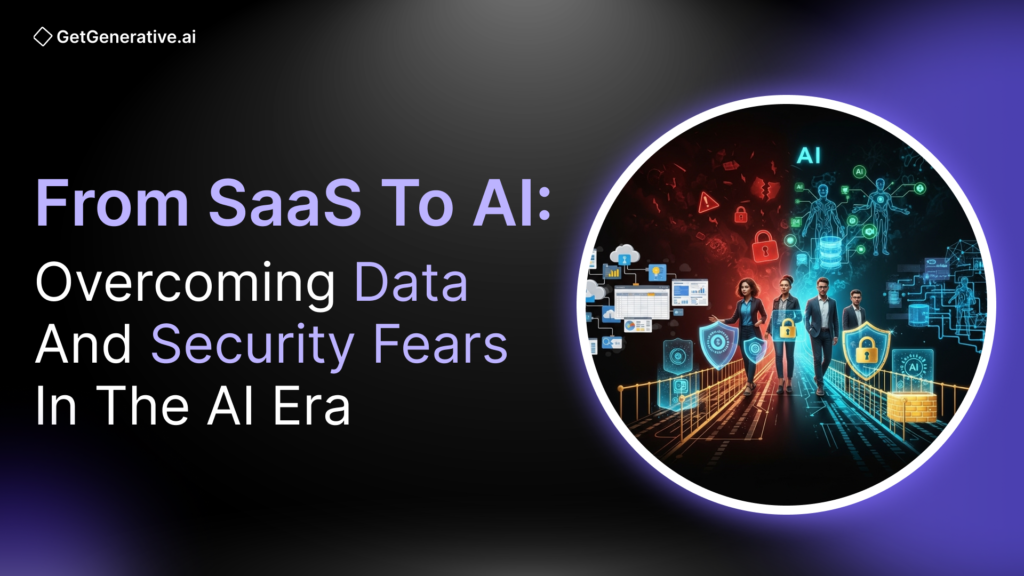From SaaS to AI: Overcoming Data and Security Fears in the AI Era
Learning from the Cloud Trust Journey
A decade ago, the idea of trusting third-party vendors with critical business data felt like a leap of faith. Cloud computing — and its most accessible form, Software-as-a-Service (SaaS) — was met with skepticism across industries.
Would storing sensitive customer information, source code, or financial records on someone else’s servers invite disaster?
Fast forward to 2025, and that leap has turned into a global standard. Today, 96% of companies rely on public cloud services, according to Gartner. More importantly, the original assumption that cloud meant weaker security has been thoroughly debunked — 94% of businesses now report improved security after migrating to the cloud.
This transformation didn’t happen by chance. It was earned through years of investment and proof. Cloud providers like AWS, Microsoft Azure, and Google Cloud developed hardened infrastructure, 24/7 threat monitoring, zero-trust architectures, and third-party certifications. With ISO 27001, SOC 2, GDPR compliance, and industry-specific standards, the cloud established itself as not just efficient but enterprise-ready.
The takeaway?
When implemented with due diligence and guided by a shared responsibility model, disruptive technologies can deliver both innovation and trust.
Cloud Breaches: Lessons in Misattribution
Despite high-profile cloud breach headlines, most incidents were not caused by flaws in the cloud itself, but by misconfigurations and human error. According to Gartner, 80% of data breaches originate on the user’s side, and 99% of cloud security failures through 2025 will be the customer’s fault.
Two real-world examples underscore this:
- Capital One (2019): A massive breach exposed 100 million customer records due to a misconfigured web application firewall. The underlying AWS infrastructure remained uncompromised — the issue was entirely on Capital One’s end. The fallout included an $80 million regulatory fine and $190 million in class-action settlements.
- Toyota (2023): A cloud misconfiguration left 260,000 customer records publicly accessible for eight years. The breach had nothing to do with a compromised cloud platform — it was a simple case of overlooked permissions.
The consistent thread in these cases is clear: security failures tend to be the result of implementation flaws, not infrastructure flaws. It’s a modern echo of the old IT adage: “A secure system can still be misused.”
The AI Inflection Point: Déjà Vu?
Today, we’re witnessing history repeat itself with Artificial Intelligence (AI) — particularly generative AI and large language models (LLMs).
The promises of AI are transformative: boosting productivity, automating knowledge work, accelerating development cycles, and uncovering insights hidden in data. Adoption is happening fast:
- Within months of its launch, ChatGPT was being used inside 80% of Fortune 500 companies — largely driven by grassroots employee adoption.
- A 2025 Bain & Company survey shows 95% of U.S. businesses are already using generative AI, a 12-point increase in just one year.
Yet, familiar concerns are rising again. Companies are asking:
- “Is our data safe with AI tools?”
- “What happens to the information we input?”
- “Can generative AI expose our proprietary content?”
These are valid questions. In 2023, Samsung temporarily banned ChatGPT after employees accidentally leaked confidential source code into prompts. An internal audit found 65% of surveyed staff considered generative AI a potential security risk if left uncontrolled.
And once again, the comparison to early cloud fears becomes relevant. Enterprises are facing an identical challenge: how to balance the productivity gains of AI with the need for control, compliance, and confidentiality.
Why AI Feels Risky — and How to De-risk It
The fear around AI tools is partly due to their interface simplicity. With a natural language prompt and zero deployment effort, anyone can ask a model to summarize customer data, generate code, or write sensitive documentation. But this simplicity masks a deeper concern — data exposure.
What happens to the data after it’s submitted to an AI tool? Could it:
- Be stored by the provider?
- Be used to train the next generation of public models?
- Leak to other users via unintentional model behavior?
These fears are not unfounded. But they are also manageable, just as they were with SaaS.
Reapplying the Cloud Trust Playbook to AI
Just like cloud providers eventually gained user trust by formalizing contracts, publishing documentation, and passing audits, AI providers must now do the same. And forward-looking vendors already are.
For example:
- OpenAI’s ChatGPT Enterprise explicitly states that it does not train its models on enterprise data, and conversations are not stored or accessed.
- Microsoft’s Azure OpenAI allows companies to run powerful models within their own VNETs, with encryption, governance, and compliance inherited from the Azure ecosystem.
- GetGenerative.ai, a rising enterprise AI platform, has proactively earned ISO 27001 and SOC 2 compliance, and offers a public Trust Portal to showcase its security architecture and safeguards.
These aren’t surface-level moves. They reflect months of architectural planning, audit preparation, policy enforcement, and transparency — the same ingredients that made cloud safe.
Key Security Considerations for Enterprise AI
To ensure safe adoption of AI, enterprises must apply the same rigor they used when evaluating cloud solutions. A “trust but verify” approach is essential, and here are the critical pillars for securing generative AI in enterprise settings:
1. Data Usage and Privacy Guarantees
Demand contractual clarity from AI vendors. The provider must commit that:
- Your data won’t be used to train public models.
- Inputs and outputs remain confidential.
- Prompts are neither stored nor reviewed unless explicitly permitted.
For instance, ChatGPT Enterprise guarantees, “We do not train on your business data or conversations.” This ensures your private information isn’t absorbed into future model updates or accessible by others.
Action Point: Always ask for these terms in writing — ideally within your Master Services Agreement (MSA) or Data Processing Agreement (DPA).
2. Isolation and Access Control
Your AI interactions should be processed in a secure, segregated environment:
- Prefer solutions that offer single-tenant deployments or virtual private cloud (VPC) setups.
- All data must be encrypted in transit and at rest.
- Only authorized users — with role-based access controls and audit logs — should be able to view or manage AI-generated content.
If the provider offers fine-tuning or persistent memory, verify how the data is handled, where it is stored, and who can access it.
Bonus Feature to Look For: Bring-Your-Own-Key (BYOK) encryption, which gives customers complete control over encryption keys.
3. Compliance and Security Certifications
Trustworthy vendors will invest in third-party audits. Look for:
- ISO/IEC 27001 (information security management)
- SOC 2 Type II (controls around security, confidentiality, availability)
- Region-specific standards like HIPAA, GDPR, or CCPA
These are not mere checkboxes — they reflect comprehensive internal controls, employee training, secure development practices, and incident response plans.
Example:
GetGenerative.ai achieved both ISO 27001 and SOC 2 Type II certifications, demonstrating its maturity in managing sensitive enterprise data.
Action Point: Don’t just trust the logo. Ask vendors to share audit summaries, security policies, or even access to a Trust Portal.
4. Transparent Terms and Control Over Your Data
Know your rights — and the vendor’s responsibilities — regarding:
- Data retention: How long will inputs/outputs be stored?
- Ownership: Do you own the AI outputs?
- Deletion rights: Can you request full deletion of data?
- Usage limitations: Will your data ever be used beyond your org?
Leading vendors now publish privacy centers and security whitepapers to answer these questions.
Caution: If you’re using a model via an intermediary (e.g., through a SaaS product), ensure the entire chain of providers follows the same standards.
5. Internal Governance: Training and Usage Policies
Even the best technology fails if humans misuse it.
Create a generative AI policy for employees. Key elements include:
- What kinds of data can be entered (e.g., no PII, no source code)?
- Which tools are approved (e.g., internal vs. public)?
- What outputs can be reused or published?
- When to involve legal or compliance?
Example Policy Language:
“Do not paste confidential client information, customer records, or unreleased product plans into public AI chat interfaces.”
Companies like JPMorgan and Apple have gone as far as to build internal generative AI tools that enforce these rules by design.
Best Practice: Add pop-up warnings, API access limits, or browser proxy filters to gently remind users of policy boundaries.
Also Read – AI-Washing in IT Consulting: Buzzwords vs Real AI-First Firms
Case Study: GetGenerative.ai’s Proactive Security Architecture
When it comes to enterprise AI adoption, transparency breeds trust. GetGenerative.ai stands out by proactively surfacing its compliance posture and internal safeguards.
What Sets It Apart:
- Early Investment in Security: From day one, the team prioritized earning certifications like ISO 27001 and SOC 2, sending a clear message to enterprise buyers.
- Public Trust Portal:
GetGenerative provides a live, always-updated Trust Portal, which includes:- Security architecture
- Encryption policies
- Certification documents
- Governance practices
- Contact information for due diligence
- Security architecture
- Comprehensive Controls:
Their platform supports:- Isolated environments for customer data
- Data encryption at every layer
- Configurable retention policies
- Role-based access
- Custom API tokens with usage limits
- Isolated environments for customer data
Why It Matters
Rather than saying “trust us,” GetGenerative.ai shows its work. This echoes the most successful strategies from the SaaS era, when trust was built through disclosure, documentation, and accountability.
Final Thoughts
The cloud era taught us that fear alone is not a strategy. Initially distrusted, cloud services are now essential infrastructure — because the industry tackled security concerns head-on.
AI is now going through the same evolution.
Yes, AI raises legitimate data and security questions. But the answers exist. We already have mature tools, trusted compliance frameworks, and proven vendor practices to reduce risk without sacrificing progress.
The AI Trust Playbook:
- Vet the provider.
- Enforce usage policies.
- Encrypt and isolate data.
- Demand transparency.
- Train your people.
Enterprises that master this playbook won’t just keep pace — they’ll pull ahead.
The benefits of AI are too significant to delay. From faster decision-making to cost savings, developer velocity, and customer personalization, the ROI is clear.



